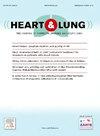A mixed methods study of backup behavior among interprofessional ICU teams
IF 2.4
4区 医学
Q2 CARDIAC & CARDIOVASCULAR SYSTEMS
引用次数: 0
Abstract
Background
Backup behavior—when clinicians help each other via verbal assistance or task completion in their roles–is essential for effective teamwork in the intensive care unit (ICU) but is not well understood. Exploring how interprofessional team members provide backup may guide future interventions.
Objective
To examine who, how often, why, and under what circumstances ICU clinicians provide backup in mechanical ventilation care.
Methods
Using a convergence, triangulation mixed methods design in 2 medical ICUs (2017–2019), we collected qualitative data (observation, shadowing, interviews) to understand how ICU teams provide backup; and patient-shift level surveys of ICU nurses, physicians, and respiratory therapists, to identify whom clinicians contacted for help that shift. We analyzed and compared these data to gain insight into the frequency, and circumstances surrounding ICU clinicians’ requests for and receipt of backup when providing mechanical ventilation care.
Results
Backup behavior was common. Interprofessional backup (e.g. nurse to respiratory therapist) related to specific patient care tasks. Intraprofessional backup (e.g. nurse to nurse) involved team members ‘checking in’ to assist their colleague. Most (57%) survey respondents reported at least one interprofessional contact on day and night shifts, and approximately 25% reported at least one intraprofessional backup contact. We identified distinct backup behavior patterns on day and night shifts.
Conclusions
While backup behavior was common, interprofessional backup focused on care aligning with professional roles whereas intraprofessional backup entailed checking-in with team members. Examining how to enhance interprofessional backup through trainings or interventions may improve how teams work and patient care.
求助全文
约1分钟内获得全文
求助全文
来源期刊

Heart & Lung
医学-呼吸系统
CiteScore
4.60
自引率
3.60%
发文量
184
审稿时长
35 days
期刊介绍:
Heart & Lung: The Journal of Cardiopulmonary and Acute Care, the official publication of The American Association of Heart Failure Nurses, presents original, peer-reviewed articles on techniques, advances, investigations, and observations related to the care of patients with acute and critical illness and patients with chronic cardiac or pulmonary disorders.
The Journal''s acute care articles focus on the care of hospitalized patients, including those in the critical and acute care settings. Because most patients who are hospitalized in acute and critical care settings have chronic conditions, we are also interested in the chronically critically ill, the care of patients with chronic cardiopulmonary disorders, their rehabilitation, and disease prevention. The Journal''s heart failure articles focus on all aspects of the care of patients with this condition. Manuscripts that are relevant to populations across the human lifespan are welcome.
 求助内容:
求助内容: 应助结果提醒方式:
应助结果提醒方式:


